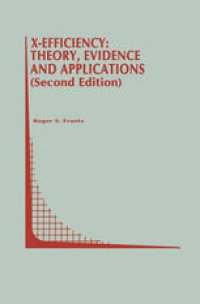
Ebook: X-Efficiency: Theory, Evidence and Applications
Author: Roger S. Frantz (auth.)
- Tags: Microeconomics, Industrial Organization
- Series: Topics in Regulatory Economics and Policy Series 23
- Year: 1997
- Publisher: Springer US
- Edition: 1
- Language: English
- pdf
My interest in X-Efficiency (XE) dates back to 1978. At the time, I was writing the dissertation for my Ph. D. at Washington State University. My dissertation was concerned with the role of attitudes in the school-to-work transition among young men. I was advised by Professor Millard Hastay (a member of my committee) to look at Leibenstein's "new" book, Beyond Economic Man. One of the things that caught my attention was his behavioral description of (selective) rationality. It seemed that Leibenstein' s behavioral description of a (selectively) rational individ ual was very similar to what psychologists such as Abraham Maslow were reporting as being the product of a particular motivational system. In other words, I was impressed with the idea that what Leibenstein was referring to as X-inefficiency was being discussed by psychologists as "the way it (often) is. " So from the beginning I always considered the concept ofX-(in)efficiency to be a valuable one for understanding human behavior. I have since come to believe that this is particularly true when considering behavior in non-market environments, i. e. , within the firm. Work on this book, however, can most realistically said to have started with work which I began in 1982 while I was a Visiting Scholar at Harvard University. Professor Leibenstein suggested that I consider how some empirical evidence which was being cited as evidence for the role of property rights might also be consistent with XE theory. (The consistency, in both directions, is considerable.
Traditional microeconomic theory is concerned with the allocation of scarce resources through the mechanism of prices and markets. The efficient allocation of resources by prices and markets is called allocative efficiency. In emphasizing the allocative function of prices and markets, microeconomic theory has ignored the allocation of resources within firms, and instead assumes that firms are always internally (X) efficient, cost minimizers. X-efficiency theory shows that protection from competitive pressures produces not only allocated market-inefficiency, but inefficiency within the firm. This book is the most current, in-depth, and comprehensive review of X-efficiency theory, especially as it relates to regulatory economics and policy. It provides an understanding of X-efficiency by developing the theory, exhibiting empirical evidence, and, finally, reviewing applications of the theory.